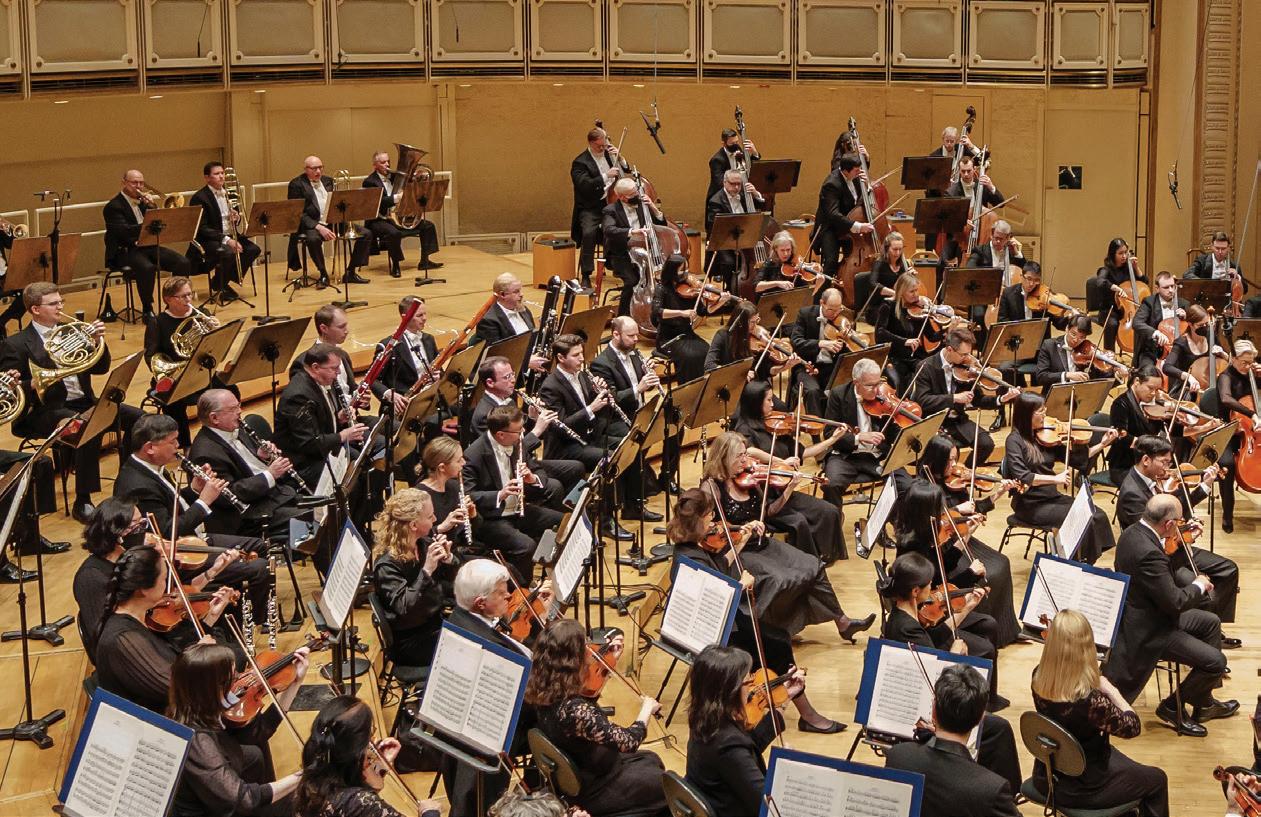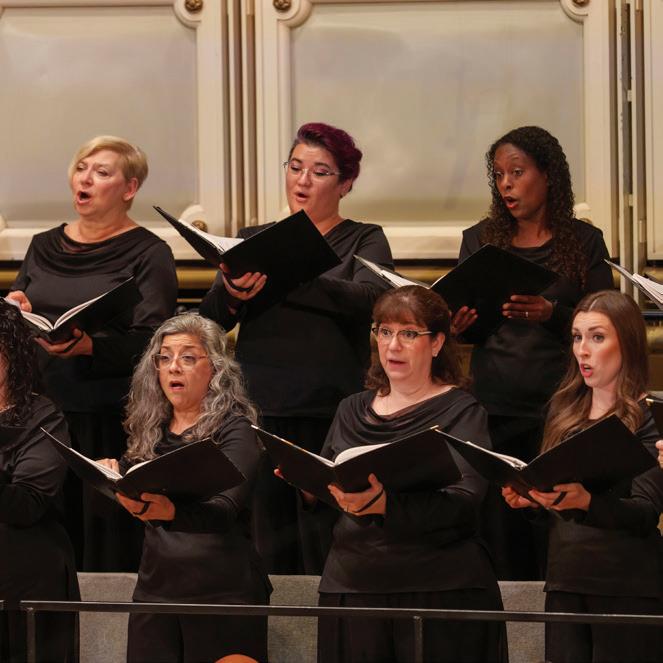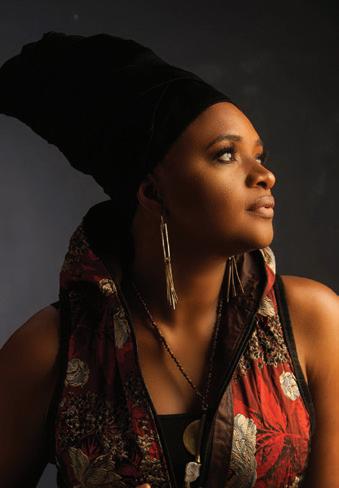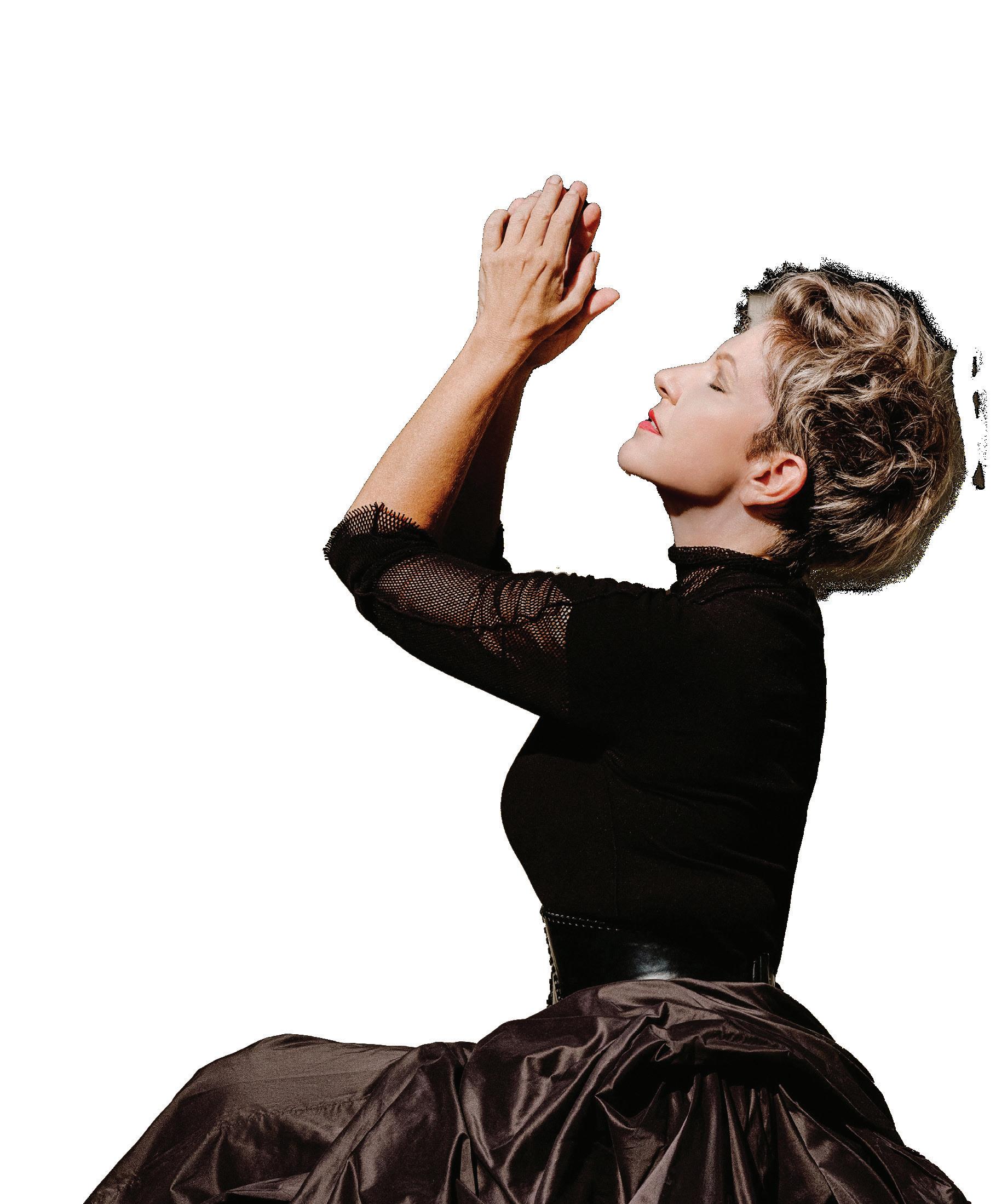


25 26 SEASON








We’ve







25 26 SEASON








We’ve





We’re honored they’ve done the same for us.

















Ranked














We believe the connection between you and your advisor is everything. It starts with a handshake and a simple conversation, then grows as your advisor takes the time to learn what matters most–your needs, your concerns, your life’s ambitions. By investing in relationships, Raymond James has built a firm where simple beginnings can lead to boundless potential.




CARLOS SIMON
Born April 13, 1986; Washington, D.C.

Carlos Simon’s website calls him a composer, curator, and activist. NPR said he “has an ear for social justice.” Simon’s 2024 Affirmations, commissioned by the LA Master Chorale, was inspired by Proverbs 18:21: “Power and life are in the tongue.”
“Simply put,” Simon says, “we are what we believe and speak about ourselves.” In his ongoing role as the Kennedy Center’s composer-in-residence since 2021, he issued a statement in February: “I don’t know what to expect as I continue, but I will not waiver in my artistic integrity.”
Simon’s music is a testament to the strength of his beliefs. His works have been inspired by the poetry by Terrance Hayes, whose writings deal with race and masculinity; the late-in-life artwork of former slave Bill Traylor; the African American Pentecostal church service he loved as a child; the writer and preacher Howard Thurman; the deaths of Trayvon Martin, Eric Garner, and Michael Brown; and his great grandfather, Henry C. Brooks, who began preaching in 1925. “My dad, he always gets on me,” Simon told the Washington Post recently. “He wants me to be a preacher, but I always tell him, ‘Music is my pulpit. That’s where I preach.’”
Simon grew up in Atlanta, a child in a long line of Black musical traditions and preachers. He played piano in his father’s church, and in high school he assumed he would become a pianist and composer. He earned a doctorate at the University of Michigan and is now an associate professor at Georgetown University. He holds the inaugural composer chair at the Boston Symphony Orchestra, the first in its history. Jessie Montgomery, the Orchestra’s former Mead Composer-inResidence, programmed three of his works on a MusicNOW concert here in 2022.
The commission for his orchestral work Fate Now Conquers came about through Simon’s participation in Gabriela Lena Frank’s Creative Academy of Music. He was asked to write a short piece as a response to one of Beethoven’s symphonies. In Fate Now Conquers, Simon takes as his starting point the famous Allegretto from the Seventh Symphony.
COMPOSED 2019
FIRST PERFORMANCE
March 26, 2020; Philadelphia, Pennsylvania
INSTRUMENTATION
2 flutes (2nd doubling piccolo), 2 oboes, 2 clarinets, 2 bassoons, 2 horns, 2 trumpets, timpani, strings
APPROXIMATE
PERFORMANCE TIME
5 minutes
FIRST CSO PERFORMANCE
July 10, 2021, Ravinia Festival. Jonathan Rush conducting These are the first subscription concert performances of Simon’s Fate Now Conquers.
above: Carlos Simon, photo by Kendall Bessent
This piece was inspired by a journal entry from Ludwig van Beethoven’s notebook, written in 1815:
Iliad. The Twenty-Second Book
But Fate now conquers; I am hers; and yet not she shall share
In my renown; that life is left to every noble spirit
And that some great deed shall beget that all lives shall inherit.
SAMUEL BARBER
Born March 9, 1910; Westchester, Pennsylvania
Died January 23, 1981; New York City

Using the beautifully fluid harmonic structure of the second movement of Beethoven’s Seventh Symphony, I have composed musical gestures that are representative of the unpredictable ways of fate—jolting stabs coupled with an agitated groove with every persona. Frenzied arpeggios in the strings that morph into an ambiguous cloud of free-flowing running passages depict the uncertainty of life that hovers over us.
We know that Beethoven strove to overcome many obstacles in his life and documented his aspirations to prevail despite his ailments. Whatever the specific reason for including this particularly profound passage from The Iliad, in the end, it seems that Beethoven relinquished to fate. Fate now conquers.
Samuel Barber grew up in a house filled with music. Practicing piano was as important as playing ball, song recitals were a favorite evening entertainment, and the names of composers and performers were dropped during dinner table conversation. Barber’s parents were not surprised when their son began playing the piano when he was six years old and composing music at seven, and they did not argue when, at the age of nine, he told them he intended to be a composer (“Don’t ask me to try and forget this unpleasant thing and go and play football,” he warned them). Sam’s aunt Louise was internationally known as Louise Homer, the great American contralto, and her husband Sydney was a highly regarded composer of songs. Shortly after Barber left the safety and comfort of his family home, he found success and encouragement in the greater music world. He was only twenty-three years old when the Philadelphia Orchestra gave the world premiere of his first orchestral score, the Overture to The School for Scandal, and soon his compositions were performed by many of the most celebrated figures of the day.
COMPOSED
1935, as opening of second movement of String Quartet in B minor, op. 11; arranged for string orchestra, 1936
FIRST PERFORMANCE
November 5, 1938, New York City. Arturo Toscanini conducting
APPROXIMATE PERFORMANCE TIME 7 minutes
FIRST CSO PERFORMANCES
July 15, 1939, Ravinia Festival. Vladimir Golschmann conducting February 12, 1955, Orchestra Hall. Wolfgang Stresemann conducting
MOST RECENT
CSO PERFORMANCES
July 13, 2010, Ravinia Festival. James Conlon conducting
October 20, 22 and 23, 2010, Orchestra Hall (no conductor)
above: Samuel Barber, portrait, 1934. Bettmann Collection, Getty Images
Nothing in Barber’s life proved more fateful than his contact with the Italian conductor Arturo Toscanini. Barber first met Toscanini in 1933, when he visited him at his summer home on the shores of Lake Maggiore in Italy. Although Toscanini rarely showed serious interest in American music, he was quite taken with Barber’s work and later said he would consider playing a short piece of his on tour with the NBC Symphony Orchestra. At Toscanini’s suggestion, Barber decided to transform the slow music from a recent string quartet into this eloquent Adagio for strings. Toscanini conducted the NBC Symphony in the premiere during a coast-tocoast broadcast in November 1938, and, almost overnight, the Adagio became as well known as any piece of American music.
Over the decades, Barber’s Adagio has reached far beyond the concert hall. It has been played at countless funerals (including those of Franklin Delano Roosevelt and Prince Rainer of Monaco), it was inevitable background music for various 9/11 memorials, and it has become part of popular culture from its abundant use in television and film. (Director David Lynch insisted on using it for the ending of his 1980 film The Elephant Man, over the objections of the film’s composer, and more famously still, Oliver Stone picked it to accompany chilling scenes of battlefield carnage in his 1986 Vietnam War epic Platoon.)
Like Mahler’s famous Adagietto from his Fifth Symphony, which Lucchino Visconti popularized in the soundtrack to his 1971 film Death in Venice, Barber’s Adagio has taken on a life of its own—one far removed from the composer’s original intent. Marked “Molto adagio espressivo cantando” (very slowly, with songlike expressiveness), Barber’s Adagio is a single long melody that moves slowly (usually in stepwise motion), unfolding and building as it weaves its way through the string orchestra. It reaches a peak and then dissolves. Although this music is now indelibly identified with tragedy and mourning, it was actually inspired by Barber’s reading of a passionate poem by Virgil from the Georgics.
In Robert Pinsky’s translation, the poem begins,
As when far off in the middle of the ocean
A breast-shaped curve of wave begins to whiten
And rise above the surface, then rolling on Gathers and gathers until it reaches land
Huge as a mountain and crashes among the rocks
With a prodigious roar, and what was deep Comes churning up from the bottom in mighty swirls
Of sunken sand and living things and water . . .
Born May 27, 1928; Barnton, Midlothian, near Edinburgh, Scotland

“As the years go by,” Thea Musgrave said the year she turned ninety—now seven years ago—
I have adopted a freer attitude towards my composing and also a more freewheeling approach to where I might start the piece (I always used to start at the beginning!), what risks I now take in the instrumental combinations, and what hours I work each day (fewer). But on the other hand, I find my life richer now—with time to enjoy my daily experience, to think about the things I really care about, and to savor what truly inspires me to compose.
Musgrave first studied at the University of Edinburgh and in Paris, where for four years in the early 1950s she worked with Nadia Boulanger—the teacher of a wide-ranging roster of celebrated composers, including Aaron Copland, Elliott Carter, Leonard Bernstein, and Philip Glass. (In 1958 Musgrave studied with Copland himself at Tanglewood.) Musgrave eventually became known for the inherently dramatic nature of her own music, whether in purely instrumental forms—she composed a series of powerful, even theatrical concertos in the late 1960s and early 1970s (for orchestra, clarinet, horn, and viola)—or in opera itself (several of hers have a historical figure as their subject, such as Mary, Queen of Scots in 1975 or Simón Bolivar in 1992).
Many of Musgrave’s works take their inspiration from the other arts—Greek legends (Orfeo and Narcissus for flute), painting (The Seasons was written after a trip to the Metropolitan Museum in New York City, and Turbulent Landscapes is a response to the paintings of J.M.W. Turner), or poetry. Her bass clarinet concerto, Autumn Sonata, which J. Lawrie Bloom and the Chicago Symphony Orchestra premiered in October 2011, was haunted by the poems of Georg Trakl, the Austrian writer who died in a Polish hospital during World War I.
COMPOSED
1989, for piccolo and piano; 2022, for piccolo and strings
FIRST PERFORMANCE
August 13, 2022, Chicago. Jennifer Gunn, piccolo; Chicago Philharmonic Orchestra, Leonard Slatkin conducting
INSTRUMENTATION solo piccolo, strings
APPROXIMATE PERFORMANCE TIME 15 minutes
These are the first Chicago Symphony Orchestra performances.

Program Annotator Phillip Huscher talks with this week’s soloist.
Phillip Huscher: Did you ever play the first version of this piece for piccolo and piano?
Jennifer Gunn: I actually never played the original version of Piccolo Play in performance. I have enjoyed others playing it and bought the music a long time ago but never got around to performing it.
How did this version for piccolo and strings come about?
The original version of Piccolo Play was commissioned by the National Flute Association, and for its fiftieth anniversary the association commissioned Thea to orchestrate Piccolo Play. I was the lucky person they asked to perform the newly commissioned piece! The Fiftieth National Flute Association Convention was held here in Chicago, and the concerto night was at Symphony Center. So, I felt right at home.
How different are the two versions?
There are very minor changes to the piccolo solo part from the original piccolo/piano version—some note changes and minor articulation changes. The noticeable differences would be in the strings’ ability to sustain more than the piano in the accompaniment lines.
There’s a great variety of piccolo writing in these seven pieces. It gives you a chance to do everything, doesn’t it?
The way Thea has used the piccolo in this piece is very enjoyable for the player. In each movement the player really gets to change characters and use different skills. For example, in the first movement the player utilizes an extreme legato or smooth sound, while in the second movement the music calls for a more percussive articulation; in the last movement, there is quite athletic use of double tonguing.
In Papillon, the fourth movement, there is a lot of unaccompanied music for piccolo. Do you think of it almost as a cadenza?
In this movement there is a lot of rhythmic freedom given to the performer. The piccolo flits around the registers with such ease, and the use of flutter tonguing feels especially descriptive to me. So, yes, it has elements of feeling like a cadenza.
Is the last movement, which flies like the wind, quite a challenge?
She marks this movement “Moto perpetuo (Il più presto possibile),” meaning perpetual motion as fast as possible. It is an intimidating marking, but one that I feel gives me energy to make it through the final pages
She marks [the final movement] “Moto perpetuo (Il più presto possibile),” meaning perpetual motion as fast as possible. It is an intimidating marking, but one that I feel gives me energy to make it through the final pages of the piece.”
of the piece. Double tonguing on wind instruments is tiring, especially when required for almost the entire last movement!
Are there moments in this piece that you especially love playing and look forward to?
I really enjoy the first movement and how the piccolo weaves around in it. It was this movement that drew me to the piece. Movement 2 is such a contrast, and the orchestra is more involved, so that makes for an interesting dialogue. The subtitle of the third movement is “the Wheedler”—I hope I can wheedle this work into the audiences’ hearts! Les Papillons, movement 4, is just fun! The freedom of movement 4 has lulled the orchestra, and now movement 5 is a chance to start waking them up for the march ahead of us in movement 6. And the last and final movement—what a way to finish!
Piccolo players are not frequent soloists with orchestras, but you’ve had previous chances to play concertos with this orchestra. That must feel like the highest honor.
This orchestra has a rich tradition of wonderful piccolo playing. My predecessor, Walfrid Kujala, was one of the leading forces on the piccolo, and I am incredibly honored to hold this chair [the Dora and John Aalbregtse Piccolo Chair]! The first time I was asked to play a concerto, I was truly shocked! That was Vivaldi’s Concerto in C major (RV 443) with Harry Bicket conducting from the harpsichord. What a magical experience! The next time I was asked to play a piccolo concerto, Maestro Muti insisted on conducting! What an incredible honor it was to play two concertos under his baton with my wonderful CSO colleagues (Benshoof’s Concerto in Three Movements and Vivaldi’s Concerto in C major, RV 444). Now that I have been asked again, I feel very proud to bring a female composer’s work to the CSO in addition to the debut appearance of Daniela Candillari. There is never a day that goes by that I don’t feel like a very lucky person.
Musgrave composed Piccolo Play “in homage” to François Couperin, the French baroque composer whose four books of harpsichord pieces—some 200 works in all, written between 1713 and 1730—are his greatest achievement and one of crowning glories of keyboard music. Musgrave was attracted above all by Couperin’s famously descriptive titles. “The titles reflect my ideas; I may be forgiven for not explaining them all,” Couperin wrote. Musgrave does not explain, but she translates each of them into pieces of startling imagination and originality that reveal, at the same time, their kinship with three-hundred-year-old keyboard jewels.
The titles of the movements of Piccolo Play are all taken from harpsichord pieces of Couperin. In each movement, the piccolo is the protagonist of the title, and the strings provide the “setting,” or background. Thus, in L’Amphibie, the strings represent the pool on which the frog leaps from leaf to leaf, disturbing the water as he goes. In Le Reveil-matin, the strings are the ones that sleep and the piccolo the alarm clock that forces them to wake. In La Pateline (The Wheedler), the piccolo is softly insistent but ultimately becomes angry as his pleas are disregarded. Le Bruit de Guerre was suggested by Manet’s The Fifer. Here the combination of different marches becomes increasingly anarchic, and innocence is overwhelmed. The end is silence, with distant echoes of the Dies irae.
Born January 4, 1710; Jesi, near Ancona, Italy
Died March 16, 1736; Pozzuoli, near Naples, Italy

Pergolesi did not live to hear his Stabat mater, which became the most often printed composition of the eighteenth century. Johann Sebastian Bach thought so highly of the Stabat mater that he made his own arrangement of the score as Psalm 51 for his use in Leipzig. Jean-Jacques Rousseau, the philosopher and composer, said that the opening movement was the most perfect and touching duet he knew. In the years after his death, Pergolesi became so popular that many works, from individual arias to cantatas, masses, and entire operas, were misattributed to him. His work list is still something of a mess. (The catalog of his compositions in the latest edition of Grove Music, the industry standard, even distinguishes between Doubtful and Extremely Doubtful works.) Like Mozart, who died very young a half century later, Pergolesi’s life quickly
COMPOSED
1735–36
FIRST PERFORMANCE date unknown
INSTRUMENTATION
2 solo voices, portativ organ, strings APPROXIMATE PERFORMANCE TIME 41 minutes
FIRST CSO PERFORMANCES
January 6, 7, and 8, 1966, Orchestra Hall. Phyllis Curtin and Betty Allen as soloists, Jean Martinon conducting
MOST RECENT
CSO PERFORMANCES
February 9, 10, and 11, 1984, Orchestra Hall. Gabriela Beňačková and Lucia Valentini-Terrani as soloists, Claudio Abbado conducting

became the stuff of myth and romantic fantasy, although since less is known about Pergolesi, conjecture and fiction have still not entirely been put to rest. Like Mozart’s Requiem, Pergolesi’s Stabat mater is one of music’s most tantalizing farewell works.
Giovanni Battista was the descendant of a shoemaker from Pergola, Italy, who married a woman from Iesi, establishing from that point on the family as Pergolesi. Giovanni Battista was born a sickly child—his brothers and sisters died as infants—and Pier Leone Ghezzi, who sketched the composer’s portrait in Rome in 1734, said that he had a deformed leg that caused him to walk with a limp. (Ghezzi’s sketch, later expanded into a full caricature, is the only known authentic image of the composer.) The fact that he was confirmed when he was just one year old suggests that critical illness may have been his companion from his earliest days.
Pergolesi made his public debut as a composer in 1731 while he was still a student at the conservatory in Naples. It was his comic opera, La serva padrona, that spread his name and became so beloved that it threatened to limit his fame to that of a one-work composer because it was frequently staged by traveling performing troupes. Within ten years of its premiere, in September 1733, it was presented more than two dozen times, from Rome and Venice to Munich and Hamburg. Its popularity remained steady throughout the eighteenth century. Its success in Paris in 1752 was so great that it sparked a battle between proponents of traditional French opera and Italian opera buffa.
In the summer of 1735 Pergolesi’s health grew worse. Il Flaminio, a comedy produced in Naples that October, was the last theatrical
success of his career. He was commissioned to write wedding music for the prince of Sansevero that December, but the second half of the serenata had to be composed by someone else. Early in the new year, Pergolesi moved into a Franciscan monastery in Pozzuoli, near Naples. There, during his final days, he composed the cantata Orfeo and his last works, Salve regina and this Stabat mater. Pergolesi’s first biographer, Marchesi di Villanova, claimed that the composer rushed to finish the score of the Stabat mater before his death because he needed the money. Pergolesi died that March, scarcely two months after his twenty-sixth birthday, and was buried in the common pit beside the cathedral in Pozzuoli. He had the shortest career of any significant composer in music—little more than five years by any reckoning.
Sometime in 1735 Pergolesi was commissioned from a brotherhood of noblemen in Naples to write a new setting of the Stabat mater text, evidently to replace the popular one by Alessandro Scarlatti, who had passed away in 1725. Like Scarlatti’s, it was to be scored for two vocal parts and strings. The poetic text, of thirteenth-century Franciscan origins, which recounts the Virgin Mary’s sorrow as she stood by the cross after Christ’s crucifixion, had often been set before—and would continue to attract composers, including Mozart (the score is lost), Haydn, Schubert, Rossini, Liszt, Dvořák, Verdi (it is one of his Four Sacred Pieces), Poulenc, and Penderecki.
The poem falls into pairs of three-line verses, which composers have divided up differently. Alessandro Scarlatti split the poem into eighteen movements. Pergolesi has just twelve, an alternating sequence of duets and arias for the
previous page : Giovanni Battista Pergolesi, a caricature in pen and brown ink by Pier Leone Ghezzi (1674–1755) during the composer’s visit to Rome around May 1734. The caption reads: “Pergolese music composer who came to Rome on 20 May 1734.” The British Museum | this page: The Gulf of Pozzuoli, oil on canvas, by Gaspar Butler (active ca. 1718–1730s), ca. 1735. Pergolesi moved to Pozzuoli—west of Naples along the coast of the Gulf of Pozzuoli—early in 1736 and died there on March 16. Yale Center for British Art Collection
two voices. (Although it was clearly intended for solo voices, there is a tradition of performing it as a choral work.) Each of the first four movements sets a single poetic verse. But then the large and dramatically varied fifth-movement duet encompasses three verses. Pergolesi was a keenly strategic composer, knowing when to linger and when to move on.
Pergolesi traverses a wide canvas of music in his twelve movements, from the deep pathos of the opening duet Rousseau admired, with its intertwining lines of lament, to music of operatic splendor. (Padre Giovanni Martini, the internationally renowned composer and teacher, thought Pergolesi sometimes veered too close
to the light patter of La serva padrona.) The arias are highly varied, ranging from slowly unfolding song, with elegant embellishment, to rapid-paced melodies with racing coloratura. Even with his spare forces, Pergolesi reaches heights of great drama. The eighth movement, “Fac, ut ardeat,” is a grand, virtuosic duet of powerful dialogue, spirited counterpoint, and virtuosic vocal writing. The final duet begins with a solemn gravity that mirrors the opening duet and then concludes with a brilliant, blazing Amen.
Phillip Huscher has been the program annotator for the Chicago Symphony Orchestra since 1987.
Stabat mater dolorosa
Iuxta crucem lacrimosa, Dum pendebat filius.
Cuius animam gementem, Contristatam et dolentem Pertransivit gladius.
O quam tristis et afflicta Fuit illa benedicta
Mater unigeniti.
Quae maerebat et dolebat Et tremebat dum videbat Nati poenas incliti.
The sorrowful Mother stood Weeping near the cross Where her Son was hanging.
Whose lamenting soul, Very sad and sorrowful, Was wounded as if pierced by the sword.
Oh, how sad and afflicted Was this blessed Mother of the Only-Begotten Son.
How she wept and suffered And trembled when she saw Her Child in agony.
Quis est homo qui non fleret
Christi matrem si videret In tanto supplicio?
Quis non posset contristari Piam matrem contemplari Dolentem cum filio?
Pro peccatis suae gentis
Vidit Jesum in tormentis Et flagellis subditum.
Vidit suum dulcem natum Morientem, desolatum, Dum emisit spiritum.
Eia, mater, fons amoris, Me sentire vim doloris
Fac ut tecum lugeam.
Fac, ut ardeat cor meum
In amando Christum Deum, Ut sibi complaceam.
Sancta mater, istud agas
Crucifixi fige plagas Cordi meo valide.
Tui nati vulnerati, Tam dignati pro me pati, Poenas mecum divide.
What man does not weep When he sees the Mother of Christ In such supplication?
Who will not share the sorrow Of the Blessed Mother Mourning for her Son?
For the sins of his people She saw Jesus in torment And suffering blows.
She saw her gentle Son Dying, desolate, While He breathed his last.
Alas, Mother, fountain of love, Make me to feel the force of your grief, Let me weep with you.
Kindle my heart With the love of Christ the Lord, That he may be pleased with me.
Holy Mother, let me suffer the Wounds of his crucifixion and Feel them in my heart—
The wounds that your Child So nobly Bore for me.
Fac me vere tecum flere
Crucifixo condolere, Donec ego vixero.
Iuxta crucem tecum stare, Te libenter sociare In planctu desidero.
Virgo virginum praeclara, Mihi iam non sis amara, Fac me tecum plangere.
Fac, ut portem Christi mortem, Passionis fac consortem, Et plagas recolere.
Fac me plagis vulnerari, Cruce hac inebriari
Ob amorem filii.
Inflammatus et accensus
Per te, virgo, sim defensus In die iudicii.
Fac me cruce custodiri
Morte Christi praemunire, Confoveri gratia.
Quando corpus morietur, Fac ut animae donetur Paradisi gloria. Amen.
Make me to share your pain, Mourning the crucifixion As long as I shall live.
Let me stand by the cross And share with you Your tears and grief.
Noble Virgin Mother, Do not reject me, Le me lament with you.
Let me bear Christ’s death, Share his suffering, And remember his wounds.
May the pain of the wounds on The cross inflame me with Love of the Son.
Inflamed and set on fire O Virgin, may I be defended by You On the day of judgment.
Let the cross watch over me, And the death of Christ protect me With the warmth of grace.
When the body dies, Grant my soul The glory of paradise. Amen.
These concerts mark Daniela Candillari’s debut with the Chicago Symphony Orchestra.

Daniela Candillari brings her artistry to opera houses and concert stages throughout North America and internationally. She is renowned for guiding groundbreaking world premieres to the stage as well as for her command of classical music’s most frequently performed masterpieces.
Candillari’s 2025–26 season of orchestra and opera engagements includes premieres with the Chicago Symphony Orchestra, Canadian Opera Company, London Philharmonic Orchestra, Royal Liverpool Philharmonic Orchestra, and the Sinfonieorchester Wuppertal. She also continues her long-term artistic relationships with Opera Theatre of Saint Louis, where she enters her fifth season as principal conductor; Music Academy of the West; and her alma mater, Indiana University Jacobs School of Music.
The 2024–25 season included world premieres with the St. Louis Symphony Orchestra (Nina Shekhar’s Accordion Concerto) and Opera Theatre of Saint Louis (This House by Ricky
Ian Gordon, Lynn Nottage, and Ruby Aiyo Gerber); debuts with the Kansas City Symphony, Tucson Symphony Orchestra, and the Louisiana Philharmonic Orchestra; and a return to the New Orleans Opera.
Her 2023–24 season opened with rave reviews for her leadership of two world premieres: 10 Days in a Madhouse by composer Rene Orth and librettist Hannah Moscovitch at Opera Philadelphia, winner of the Best New Opera Award by the Music Critics Association of North America; and Jeanine Tesori’s Grounded to a libretto by George Brant with Washington National Opera at the Kennedy Center, a company debut. She has conducted the New York Philharmonic and the Orchestre Métropolitain de Montréal in addition to leading productions at the Metropolitan Opera, Deutsche Oper Berlin, Lyric Opera of Chicago, Minnesota Opera, and Detroit Opera.
Daniela Candillari grew up in Serbia and Slovenia. She holds a doctorate in musicology from the University of Music and Performing Arts Vienna, a master’s degree in jazz studies from Indiana University Jacobs School of Music, and master’s and bachelor’s degrees in piano performance from the University of Music and Performing Arts Graz. A Fulbright Scholarship recipient, she was also awarded a TED Fellowship.
BY
FIRST CSO PERFORMANCES
May 22, 23, 24, and 27, 2008, Orchestra Hall. Vivaldi’s Piccolo Concerto in C major, RV 443; Harry Bicket conducting
MOST RECENT CSO PERFORMANCES
June 13, 14, and 15, 2019, Orchestra Hall. Vivaldi’s Piccolo Concerto in C major, RV 444 and Benshoof’s Concerto in Three Movements; Riccardo Muti conducting

Jennifer M. Gunn was appointed flute and piccolo of the Chicago Symphony Orchestra by Daniel Barenboim in 2005. In December 2020 the position was endowed as the Dora and John Aalbregtse Piccolo Chair. She has been active in the life of the Orchestra in many ways, including performances on its contemporary music series MusicNOW, the CSO Chamber Music series, and the Once Upon a Symphony series. Gunn also has served as a piccolo and flute coach for the Civic Orchestra of Chicago, participated in the Dream Out Loud Music Education Advocacy Campaign, and joined Music Director Emeritus for Life Riccardo Muti for several of the programs for at-risk and incarcerated youth at Chicago-area juvenile justice centers.
Gunn has been featured as a soloist with the Orchestra on many occasions. She made her solo flute debut under the direction of Ludovic Morlot on the MusicNOW series in Shirish Korde’s Nesting Cranes in 2007. A year later, she made her solo piccolo debut under the direction of Harry Bicket in Vivaldi’s Piccolo Concerto in C major (RV 443). Gunn also has been featured as a flutist in Bach’s Brandenburg Concertos with her CSO colleagues with both Nicholas Kraemer and Pinchas Zukerman. In 2019 Gunn was soloist under Riccardo Muti in Vivaldi’s
Piccolo Concerto in C major (RV 444) and gave the CSO premiere of Ken Benshoof’s Concerto in Three Movements for Piccolo and Orchestra. Gunn has joined her colleagues in a variety of performance settings. In the Chicago area, she has been a guest with the Bach Week Festival, Dempster Street Pro Musica, Music of the Baroque, and the Civitas Ensemble. Beyond Chicago, she has collaborated at the Sunflower Music Festival in Topeka, Kansas; Buzzards Bay Musicfest in Marion, Massachusetts; Arizona Musicfest in Scottsdale, Arizona; and the St. Bart’s Music Festival in Saint Barthélemy, French West Indies. She can also be heard on recordings featuring the music of Mason Bates, Anna Clyne, and Victoria Bond, as well as those of the Orchestra on the CSO Resound label.
In demand as a clinician, Jennifer Gunn has taught master classes around the world and served as a guest artist at the 2018 International Piccolo Festival in Grado, Italy. She is a frequent guest at universities around the country, teaching master classes at Butler School of Music at the University of Texas–Austin, University of Illinois at Urbana-Champaign, University of Missouri–Kansas City, and Northwestern University. Gunn also has been an orchestral coach with the National Youth Symphony and the New World Symphony in Miami Beach.
Jennifer Gunn has held previous positions including assistant principal flute of the Louisville Orchestra, principal flute of the Fort Wayne Philharmonic, and second flute of the Wheeling Symphony Orchestra. She holds a bachelor’s degree from the Mary Pappert School of Music at Duquesne University in Pittsburgh, where she studied with Robert Langevin and Rhian Kenny. She also studied at the University of Akron with George Pope and Mary Kay Robinson.
She is married to Jonathan Gunn, professor of clarinet at University of Texas Butler School of Music.
PHOTO BY TODD ROSENBERG
These concerts mark Giulia Semenzato’s debut with the Chicago Symphony Orchestra.

Italian soprano Giulia Semenzato is acclaimed for her vibrant stage presence and crystalline tone, with distinction in baroque repertoire and works by Mozart. Semenzato’s 2025–26 season highlights include reprising the role of Zerlina in Mozart’s Don Giovanni with the Budapest Festival Orchestra under Iván Fischer on tour, the title role in Monteverdi’s L’incoronazione di Poppea at the Drottningholm Palace Theatre, and her debut with the Vienna Symphony Orchestra in Schmidt’s The Book with Seven Seals conducted by Fabio Luisi. She also tours as soloist in Bach’s Saint Matthew Passion with Arcangelo led by Jonathan Cohen and sings Mozart’s Requiem with the Czech Philharmonic Orchestra and Giovanni Antonini.
Last season, Semenzato returned to several leading houses, including Oper Frankfurt for her role debut as Iole in Handel’s Hercules, Susanna in Le nozze di Figaro at Teatro Regio Torino, Dorinda in Orlando at the Théâtre du Châtelet in Paris, and Fortuna in I Grotteschi—a new pastiche based on the music of Monteverdi—at La Monnaie in Brussels.
Recent highlights include Nanetta (Falstaff) at the Salzburg Festival and Beijing National Centre for the Performing Arts, Dido (Dido and Aeneas) at the Bavarian State Opera, Dorinda (Orlando) at the Teatro Real in Madrid and Theater an der Wien in Vienna, and Ilia (Idomeneo) at Grand Théâtre de Genève. A
frequent guest at leading European houses, Semenzato has appeared at Teatro alla Scala (Lucio Silla, La finta Giardiniera, Don Giovanni, Falstaff), Teatro La Fenice in Venice (Juditha Triumphans, Ottone in Villa, Don Giovanni), the Royal Opera House in London (Le nozze di Figaro), Opéra national du Rhin (L’incoronazione di Poppea), Paris’s Opéra-Comique, and the Aixen-Provence Festival, among others.
Equally active on the concert stage, Giulia Semenzato has appeared as a soloist in Mozart’s Requiem (Naples, Madrid, Cuenca); Fauré’s Requiem with Tonhalle-Orchester Zürich; Handel’s Messiah with Collegium 1704 and in Melk under Daniel Harding; Poulenc’s Gloria at Teatro Regio Torino and Teatro Carlo Felice di Genova; and Caldara’s Maddalena ai piedi di Cristo at the Paris Philharmonie, Hamburg Elbphilharmonie, and Berlin Philharmonie.
Semenzato has recorded for the Accent, Arcana, Glossa, Harmonia Mundi, CPO, and Pentatone labels. She recently released her first solo album, Angelica Diabolica, on Alpha Classics. She has also held master classes for baroque singing at the University of Arts of Havana in Cuba and the Venice School of Early Music. She is currently professor of voice in the Early Music Department of the Vienna University of Music and Performing Arts.
An honors graduate of the Conservatorio Benedetto Marcello in Venice and the Schola Cantorum Basiliensis in Basel, where she studied under Rosa Domínguez, Giulia Semenzato gained recognition winning top prizes at the Toti dal Monte International Opera Competition, the Farinelli Award in Bologna, and the Cesti Competition in Innsbruck. Her career was launched with her debut as Elisetta (Il matrimonio segreto) in Treviso, Lucca, Ferrara, and Pisa.
BY
Jennifer Johnson Cano Mezzo-soprano
FIRST CSO PERFORMANCES
February 24, 25, 26, and 27, 2022, Orchestra Hall. Beethoven’s Symphony no. 9, Riccardo Muti conducting
MOST RECENT CSO PERFORMANCES
March 13, 14, and 15, 2025, Orchestra Hall. Haydn’s Mass in C major (Mass in Time of War), Manfred Honeck conducting

After Jennifer Johnson Cano’s portrayal of Michele in the premiere of Gregory Spears’s The Righteous at Santa Fe Opera earned her accolades from publications including the New York Times, Musical America, the Wall Street Journal, and Opera News in the summer of 2024, she was invited back as Mrs. Grose in Britten’s The Turn of the Screw as well as Schwertleite in Wagner’s Die Walküre in the summer of 2025. Her 2025–26 season includes engagements with the San Francisco, Colorado, and Seattle symphony orchestras and the Apollo Orchestra. The Philadelphia Chamber Music Society presents her in recital with pianist Christopher Cano and violist Beth Guterman Chu. Tours include a project with Simone Dinnerstein and her ensemble Baroklyn (following Cano’s appearance on Complicité, Dinnerstein’s 2025 recording on Supertrain Records) as well as the National Symphony Orchestra of Taiwan Chamber Music Festival in January. She returns to the Metropolitan Opera in her role debut as Suzuki in Madama Butterfly. She and Christopher Cano will also premiere a new song cycle by Gregory Spears at the Tucson Desert Song Festival. Cano undertakes a balance of orchestral, opera, and chamber music performances each
season. Recent highlights include Hermia in Britten’s A Midsummer Night’s Dream with Opera Theatre of St. Louis and Mistress Quickly in Falstaff at Houston Grand Opera.
Highlights of her operatic career have included such roles as Donna Elvira, Carmen, and Offred with Boston Lyric Opera; the Fox in The Cunning Little Vixen with the Cleveland Orchestra; the Mother, Dragonfly, and Squirrel in L’enfant et les sortilèges with the San Francisco Symphony; El Niño with John Adams and the London Symphony Orchestra; Carmen with New Orleans Opera; and Orphée with Des Moines Metro Opera and Opera Theatre of Saint Louis. She has appeared in more than 100 performances at the Metropolitan Opera since her debut in the 2009–10 season. Cano premiered the role of Virginia Woolf in the world premiere of Kevin Puts’s The Hours with the Philadelphia Orchestra.
A native of St. Louis, Missouri, Jennifer Johnson Cano earned degrees from Rice University and Webster University, where she was honored as a distinguished alumna and commencement speaker in 2017. Her debut recital recording with Christopher Cano, Unaffected: Live from the Savannah Voice Festival, was unedited. She is a soloist on a live recording of Beethoven’s Symphony no. 9 with the Pittsburgh Symphony and Manfred Honeck and in Bernstein’s Symphony no. 1 (Jeremiah) with the Baltimore Symphony Orchestra and Marin Alsop. She also recorded Mahler’s Das Lied von der Erde with the St. Luke’s Chamber Ensemble.
Jennifer Johnson Cano joined the Lindemann Young Artist Development Program at the Met after winning the Metropolitan Opera National Council Auditions. Among her honors are winning the Young Concert Artist International Auditions, a Sara Tucker Study Grant, a Richard Tucker Career Grant, and a George London Award.
BY GRANT LEGAN


A fundraising event presented by the League of the Chicago Symphony Orchestra Association, featuring Zell Music Director Designate Klaus Mäkelä and violist Antoine Tamestit.
FRIDAY, OCTOBER 17
11:00 am | Guest Check-In
11:30 am | Luncheon
12:30 pm | Program
UNION LEAGUE CLUB OF CHICAGO
Presidents Hall | 65 W. Jackson Blvd., Chicago, IL 60604
TICKETS $250
For event tickets and more information, visit cso.org/fallinlove.
HOSTED BY
Sarah Good, President
Sharon Mitchell, Vice President of Fundraising
Mimi Duginger and Margo Oberman, Co-Chairs
Contact Brent Taghap at taghapb@cso.org with event-related questions.
The Chicago Symphony Orchestra—consistently hailed as one of the world’s best—marks its 135th season in 2025–26. The ensemble’s history began in 1889, when Theodore Thomas, the leading conductor in America and a recognized music pioneer, was invited by Chicago businessman Charles Norman Fay to establish a symphony orchestra. Thomas’s aim to build a permanent orchestra of the highest quality was realized at the first concerts in October 1891 in the Auditorium Theatre. Thomas served as music director until his death in January 1905, just three weeks after the dedication of Orchestra Hall, the Orchestra’s permanent home designed by Daniel Burnham.
Frederick Stock, recruited by Thomas to the viola section in 1895, became assistant conductor in 1899 and succeeded the Orchestra’s founder. His tenure lasted thirty-seven years, from 1905 to 1942—the longest of the Orchestra’s music directors. Stock founded the Civic Orchestra of Chicago— the first training orchestra in the U.S. affiliated with a major orchestra—in 1919, established youth auditions, organized the first subscription concerts especially for children, and began a series of popular concerts.
Three conductors headed the Orchestra during the following decade: Désiré Defauw was music director from 1943 to 1947, Artur Rodzinski in 1947–48, and Rafael Kubelík from 1950 to 1953. The next ten years belonged to Fritz Reiner, whose recordings with the CSO are still considered hallmarks. Reiner invited Margaret Hillis to form the Chicago Symphony Chorus in 1957. For five seasons from 1963 to 1968, Jean Martinon held the position of music director.
Sir Georg Solti, the Orchestra’s eighth music director, served from 1969 until 1991. His arrival launched one of the most successful musical partnerships of our time. The CSO made its first overseas tour to Europe in 1971 under his direction and released numerous award-winning recordings. Beginning in 1991, Solti held the title of music director laureate and returned to conduct the Orchestra each season until his death in September 1997.
Daniel Barenboim became ninth music director in 1991, a position he held until 2006. His tenure was distinguished by the opening of Symphony Center in 1997, appearances with the Orchestra in the dual role of pianist and conductor, and twenty-one international tours. Appointed by Barenboim in 1994 as the Chorus’s second director, Duain Wolfe served until his retirement in 2022.
In 2010, Riccardo Muti became the Orchestra’s tenth music director. During his tenure, the Orchestra deepened its engagement with the Chicago community, nurtured its legacy while supporting a new generation of musicians and composers, and collaborated with visionary artists. In September 2023, Muti became music director emeritus for life.
In April 2024, Finnish conductor Klaus Mäkelä was announced as the Orchestra’s eleventh music director and will begin an initial five-year tenure as Zell Music Director in September 2027. In July 2025, Donald Palumbo became the third director of the Chicago Symphony Chorus.
Carlo Maria Giulini was named the Orchestra’s first principal guest conductor in 1969, serving until 1972; Claudio Abbado held the position from 1982 to 1985. Pierre Boulez was appointed as principal guest conductor in 1995 and was named Helen Regenstein Conductor Emeritus in 2006, a position he held until his death in January 2016. From 2006 to 2010, Bernard Haitink was the Orchestra’s first principal conductor.
Mezzo-soprano Joyce DiDonato is the CSO’s Artist-in-Residence for the 2025–26 season.
The Orchestra first performed at Ravinia Park in 1905 and appeared frequently through August 1931, after which the park was closed for most of the Great Depression. In August 1936, the Orchestra helped to inaugurate the first season of the Ravinia Festival, and it has been in residence nearly every summer since.
Since 1916, recording has been a significant part of the Orchestra’s activities. Recordings by the Chicago Symphony Orchestra and Chorus— including recent releases on CSO Resound, the Orchestra’s recording label launched in 2007— have earned sixty-five Grammy awards from the Recording Academy.



The CSO African American Network aims to engage Chicago’s culturally rich African American community through the sharing and exchanging of unforgettable musical experiences while building relationships for generations to come. The AAN seeks to serve and encourage individuals, families, educators, students, musicians, composers and businesses to discover and experience the timeless beauty of music.
Be a part of the season with concerts across musical genres highlighting world-class performances and compositions from Christian McBride, Julia Bullock, Lizz Wright, Mike Reed, Wynton Marsalis and more!





Klaus Mäkelä Zell Music Director Designate
Joyce DiDonato Artist-in-Residence
VIOLINS
Robert Chen Concertmaster
The Louis C. Sudler Chair, endowed by an
anonymous benefactor
Stephanie Jeong
Associate Concertmaster
The Cathy and Bill Osborn Chair
David Taylor*
Assistant Concertmaster
The Ling Z. and Michael C.
Markovitz Chair
Yuan-Qing Yu*
Assistant Concertmaster
So Young Bae
Cornelius Chiu
Gina DiBello
Kozue Funakoshi
Russell Hershow
Qing Hou
Gabriela Lara
Matous Michal
Simon Michal
Sando Shia
Susan Synnestvedt
Rong-Yan Tang
Baird Dodge Principal
Danny Yehun Jin
Assistant Principal
Lei Hou
Ni Mei
Hermine Gagné
Rachel Goldstein
Mihaela Ionescu
Melanie Kupchynsky §
Wendy Koons Meir
Ronald Satkiewicz ‡
Florence Schwartz
VIOLAS
Teng Li Principal
The Paul Hindemith Principal Viola Chair
Catherine Brubaker
Youming Chen
Sunghee Choi
Wei-Ting Kuo
Danny Lai
Weijing Michal
Diane Mues
Lawrence Neuman
Max Raimi
John Sharp Principal
The Eloise W. Martin Chair
Kenneth Olsen
Assistant Principal
The Adele Gidwitz Chair
Karen Basrak §
The Joseph A. and Cecile Renaud Gorno Chair
Richard Hirschl
Daniel Katz
Katinka Kleijn
Brant Taylor
The Ann Blickensderfer and Roger Blickensderfer Chair
BASSES
Alexander Hanna Principal
The David and Mary Winton
Green Principal Bass Chair
Alexander Horton
Assistant Principal
Daniel Carson
Ian Hallas
Robert Kassinger
Mark Kraemer
Stephen Lester
Bradley Opland
Andrew Sommer
FLUTES
Stefán Ragnar Höskuldsson § Principal
The Erika and Dietrich M.
Gross Principal Flute Chair
Emma Gerstein
Jennifer Gunn
PICCOLO
Jennifer Gunn
The Dora and John Aalbregtse Piccolo Chair
OBOES
William Welter Principal
Lora Schaefer
Assistant Principal
The Gilchrist Foundation, Jocelyn Gilchrist Chair
Scott Hostetler
ENGLISH HORN
Scott Hostetler
Riccardo Muti Music Director Emeritus for Life
CLARINETS
Stephen Williamson Principal
John Bruce Yeh
Assistant Principal
The Governing
Members Chair
Gregory Smith
E-FLAT CLARINET
John Bruce Yeh
BASSOONS
Keith Buncke Principal
William Buchman
Assistant Principal
Miles Maner
HORNS
Mark Almond Principal
James Smelser
David Griffin
Oto Carrillo
Susanna Gaunt
Daniel Gingrich ‡
TRUMPETS
Esteban Batallán Principal
The Adolph Herseth Principal Trumpet Chair, endowed by an anonymous benefactor
John Hagstrom
The Bleck Family Chair
Tage Larsen
TROMBONES
Timothy Higgins Principal
The Lisa and Paul Wiggin
Principal Trombone Chair
Michael Mulcahy
Charles Vernon
BASS TROMBONE
Charles Vernon
TUBA
Gene Pokorny Principal
The Arnold Jacobs Principal Tuba Chair, endowed by Christine Querfeld
* Assistant concertmasters are listed by seniority. ‡ On sabbatical § On leave
The CSO’s music director position is endowed in perpetuity by a generous gift from the Zell Family Foundation. The Louise H. Benton Wagner chair is currently unoccupied.
TIMPANI
David Herbert Principal
The Clinton Family Fund Chair
Vadim Karpinos
Assistant Principal
PERCUSSION
Cynthia Yeh Principal
Patricia Dash
Vadim Karpinos
LIBRARIANS
Justin Vibbard Principal
Carole Keller
Mark Swanson
CSO FELLOWS
Ariel Seunghyun Lee Violin
Jesús Linárez Violin
The Michael and Kathleen Elliott Fellow
Olivia Jakyoung Huh Cello
ORCHESTRA PERSONNEL
John Deverman Director
Anne MacQuarrie
Manager, CSO Auditions and Orchestra Personnel
STAGE TECHNICIANS
Christopher Lewis
Stage Manager
Blair Carlson
Paul Christopher
Chris Grannen
Ryan Hartge
Peter Landry
Joshua Mondie
The Chicago Symphony Orchestra string sections utilize revolving seating. Players behind the first desk (first two desks in the violins) change seats systematically every two weeks and are listed alphabetically. Section percussionists also are listed alphabetically.
Discover more about the musicians, concerts, and generous supporters of the Chicago Symphony Orchestra Association online, at cso.org.
Find articles and program notes, listen to CSOradio, and watch CSOtv at Experience CSO.
cso.org/experience
Get involved with our many volunteer and affiliate groups.
cso.org/getinvolved
Connect with us on social @chicagosymphony

Chicago Symphony Orchestra Association Board of Trustees
OFFICERS
Mary Louise Gorno Chair
Chester A. Gougis Vice Chair
Steven Shebik Vice Chair
Helen Zell Vice Chair
Renée Metcalf Treasurer
Jeff Alexander President
Kristine Stassen Secretary of the Board
Stacie M. Frank Assistant Treasurer
Dale Hedding Vice President for Development
Chicago Symphony Orchestra Association Administration
SENIOR LEADERSHIP
Jeff Alexander President
Stacie M. Frank Vice President & Chief Financial Officer, Finance and Administration
Dale Hedding Vice President, Development
Ryan Lewis Vice President, Sales and Marketing
Vanessa Moss Vice President, Orchestra and Building Operations
Cristina Rocca Vice President, Artistic Administration
The Richard and Mary L. Gray Chair
Eileen Chambers Director, Institutional Communications
Jonathan McCormick Managing Director, Negaunee Music Institute at the CSO
Visit cso.org/csoa to view a complete listing of the CSOA Board of Trustees and Administration.
For complete listings of our generous supporters, please visit the Richard and Helen Thomas Donor Gallery.
cso.org/donorgallery












